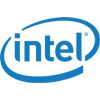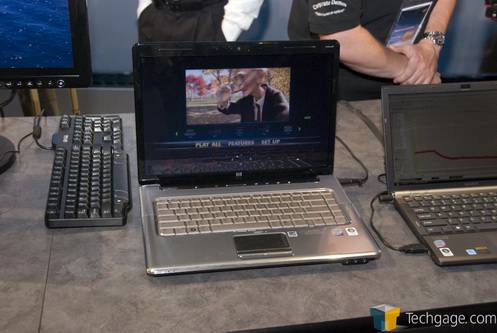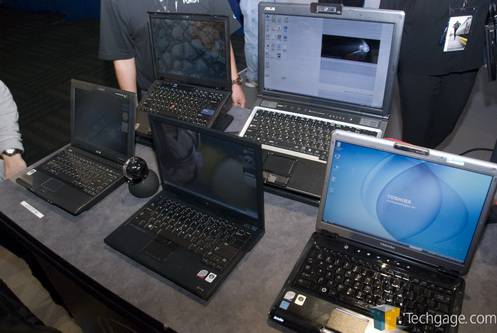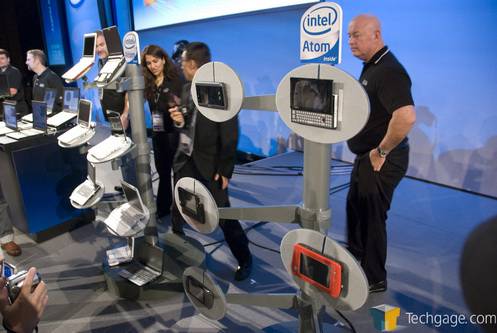- Qualcomm Launches Snapdragon 4 Gen 2 Mobile Platform
- AMD Launches Ryzen PRO 7000 Series Mobile & Desktop Platform
- Intel Launches Sleek Single-Slot Arc Pro A60 Workstation Graphics Card
- NVIDIA Announces Latest Ada Lovelace Additions: GeForce RTX 4060 Ti & RTX 4060
- Maxon Redshift With AMD Radeon GPU Rendering Support Now Available
IDF 08 SF: Day 1 Keynote Roundup

Greetings from the Fall 2008 Intel Developer Forum! Day 1 is done, and we’ve already heard speeches from some of the biggest names at the company, regarding new products and the company’s future direction, as well as the significance of technological progress worldwide. We’ve got your details about what was said, and who said it.
Page 2 – Pat Gelsinger, Cont’d.; Dadi Perlmutter
Gelsinger concluded his keynote with some remarks on Larrabee, including some technology demos. One demonstration featuring transparency demonstrated the way that the Larrabee GPU could provide the necessary texture sorting to ensure that transparencies could be properly conserved. Another demonstration highlighted the Larrabee processor’s programmability, through an ‘irregular Z-buffer’ application for smoothing the edges of reflections. Implementation of such a Z-buffer would require an additional stage in the graphics pipeline, and a complete redesign of a traditional GPU, but with Larrabee, all that needs to be added is another programmable step.
Pat Gelsinger’s keynote touched on a wide variety of exciting new technologies (Nehalem, Larrabee) and injected new excitement into some that we’ve already seen (in the case of Atom). We can’t wait to see how the face and nature of computing will change as a result of these new technologies, as the internet goes integrated with Atom, scalable processor architectures take over with Nehalem, and graphics processors go programmable with Larrabee, All three of these new technologies are built on Intel x86 processor technology, and are part of the company’s push to expand x86’s reach.
Dadi Perlmutter: “Where Will ‘On-the-Go’ Go Next?”
The Pat Gelsinger keynote segued directly into the next keynote, by Intel’s Executive Vice President and General Manager of Intel’s Mobility Group, Dadi Perlmutter. Perlmutter’s speech was entitled “Where Will ‘On-the-Go’ Go Next?” At the start of the keynote, Dadi made a staggering prediction: 1 billion mobile internet access devices will ship next year. This includes notebook PCs, netbooks, UMPCs, and internet-connected cell phones. Dadi reinforced this prediction by highlighting the transition from desktop PCs to notebook PCs, in terms of yearly sales. Laptop sales are expected to steal the desktop PC’s slim lead in 2009, and only continue to grow from there, as desktop PC sales grow at a much slower rate.
To address this growth, Dadi described Intel’s threefold product approach. First, Intel is about to begin shipments of low-power quad-core CPUs specifically for use in notebooks, and Nehalem’s power-thrifty design is only expected to widen the quad-core performance envelope further as it makes its transition to mobile CPUs. The problem with shoehorning a quad-core CPU into a notebook PC is that power requirements increase, and thermal requirements increase accordingly.
In a domino-effect, those power and thermal requirements require larger battery packs, and additional size, weight, and noise for thermal management. However, the future of mobile quad-core CPUs from Intel will bring with it a transition to smaller and lighter devices with multi-core computing power.
The next prong in Intel’s approach to mobile computing, as Dadi explained, is the Centrino 2 (Montevina) platform, which reduces power requirements from other parts of the mobile machine, and further helps to preserve the thin, light form factor and design that customers demand in their mobile PCs. The primary way it accomplishes this is by dynamically controlling the CPU’s speed and voltage through Intel SpeedStep technology.
Dadi demonstrated a Centrino 2-based machine with a SSE4-capable Intel Core 2 Duo CPU side-by-side with a machine based on the original Centrino platform, with a Core Duo CPU. The SSE4-enabled Core 2 CPU absolutely smoked the earlier Core CPU in a Sony Vegas encoding run, finishing in only a fraction of the time. By the time Dadi moved on from that demonstration, the earlier Core-based notebook was still churning away on the encoding task.
Dadi also demonstrated a Sony VAIO notebook PC (which we reported on in our ‘news’ section some time ago when it first arrived), which allows the user to switch between a third-party discrete graphics processor and the Intel chipset’s integrated graphics core. This enables a major benefit of hybrid-graphics operation that was previously only available in chipsets from NVIDIA or ATI. Another demonstration showed that a laptop machine with Centrino 2 power-saving technology is capable of playing a typical 1080p Blu-Ray movie on a single battery charge.
The third prong of Intel’s approach to mobile computing is the Atom processor, which endows MIDs, subnotebooks, ‘netbooks’, and UMPCs with performance that was only seen earlier in processor industry black sheep VIA’s line of ultra low power CPUs. However, Dadi left coverage of the MID and UMPC product range to Anand Chandrasekher’s Wednesday morning keynote.
Final Thoughts
This year’s Intel Developer Forum conference is shaping up to be one of the most exciting IDFs ever. Not only are we witnessing evolutionary improvements in CPU technology, but Intel is using the event to showcase the multitude of new directions that the company is taking as it works to lead technology development in the lucrative new markets that are opening up in the rapidly-changing PC and consumer electronics industry. We’ll have more coverage of this year’s IDF forthcoming, but Tuesday proved to be the most exciting and information-rich day of the conference.
Discuss in our forums!
If you have a comment you wish to make on this article, feel free to head on into our forums! There is no need to register in order to reply to such threads.
Support our efforts! With ad revenue at an all-time low for written websites, we're relying more than ever on reader support to help us continue putting so much effort into this type of content. You can support us by becoming a Patron, or by using our Amazon shopping affiliate links listed through our articles. Thanks for your support!







